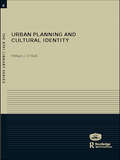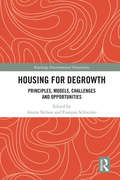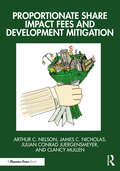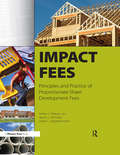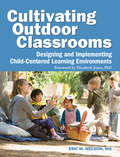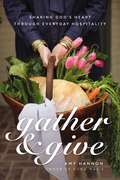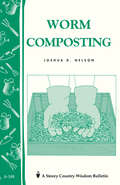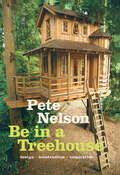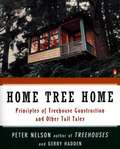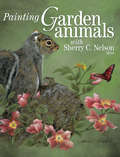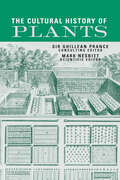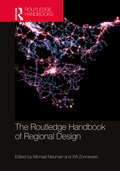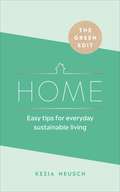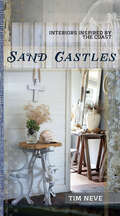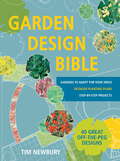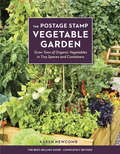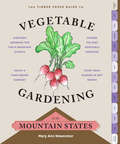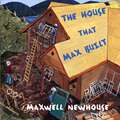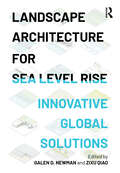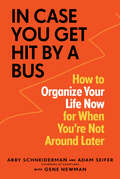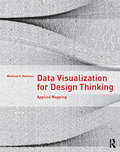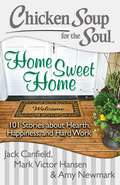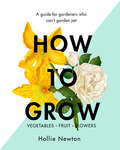- Table View
- List View
Simple Acts to Save Our Planet: 500 Ways to Make a Difference (Simple Acts)
by Michelle NeffSimple Acts to Save Our Planet shows you how to be more active in saving our planet every day by performing some “Simple Acts of Kindness”—for the Earth.Treat the environment with kindness with these easy, manageable activities that range from simple home updates, to gardening basics, to supporting the local community. You’ll learn simple techniques to help protect the planet every day, like starting a compost pile to reduce food waste, utilizing travel mugs and reusable containers, and choosing eco-friendly products. By working to implement these simple strategies into your everyday life, you can take an active stand to protect the environment now— and make a real difference for the future.
Urban Planning and Cultural Identity (RTPI Library Series #Vol. 6)
by William NeillUrban Planning and Cultural Identity reviews the intense spatiality of conflict over identity construction in three cities where culture and place identity are not just post-modernist playthings but touch on the raw sensibilities of who people define themselves to be. Berlin as the reborn German capital has put 'coming to terms with' the Holocaust and the memory of the GDR full square at the centre of urban planning. Detroit raises questions about the impotence and complicity of planners in the face of the most extreme metropolitan spatial apartheid in the United States and where African-American identity now seems set on a separatist course. In Belfast, in the clash of Irish nationalist and Ulster unionist traditions, place can take on intense emotional meanings in relation to which planners as 'mediators of space' can seem ill equipped.The book, drawing on extensive interview sources in the case study cities, poses a question of broad relevance. Can planners fashion a role in using environmental concerns such as Local Agenda 21 as a vehicle of building a sense of common citizenship in which cultural difference can embed itself?
Housing for Degrowth: Principles, Models, Challenges and Opportunities (Routledge Environmental Humanities)
by Anitra Nelson François Schneider‘Degrowth’, a type of ‘postgrowth’, is becoming a strong political, practical and cultural movement for downscaling and transforming societies beyond capitalist growth and non-capitalist productivism to achieve global sustainability and satisfy everyone’s basic needs. This groundbreaking collection on housing for degrowth addresses key challenges of unaffordable, unsustainable and anti-social housing today, including going beyond struggles for a 'right to the city' to a 'right to metabolism', advocating refurbishment versus demolition, and revealing controversies within the degrowth movement on urbanisation, decentralisation and open localism. International case studies show how housing for degrowth is based on sufficiency and conviviality, living a ‘one planet lifestyle’ with a common ecological footprint. This book explores environmental, cultural and economic housing and planning issues from interdisciplinary perspectives such as urbanism, ecological economics, environmental justice, housing studies and policy, planning studies and policy, sustainability studies, political ecology, social change and degrowth. It will appeal to students and scholars across a wide range of disciplines.
Planner's Estimating Guide: Projecting Land-Use and Facility Needs
by Arthur NelsonThe United States faces enormous changes in the next 25 years. Arthur C. (Chris) Nelson starts this book with a few projections: The population will grow by one-third to 375 million. We will need 60 million new housing units to house these people. There will be 60 percent more jobs, requiring 50 billion additional square feet of nonresidential space. The bottom line is that half of all development in 2030 will have been built since 2000. Nelson estimates the cost of new construction alone to be at least $20 trillion. This book gives planning practitioners a powerful tool to help decide where to put this new development. It does not advocate one development scenario over another, but it revolutionizes the job of estimating land-use and facility needs. Planner's Estimating Guide offers easy-to-use formulas and worksheets that are formatted in an Excel workbook on CD-ROM and carefully explained in the text. They make it easy to figure future requirements for countless scenarios. The workbook and text deal with a 20-year planning horizon for a fictitious county, but both the time projection and scale are entirely adaptable to myriad local circumstances. The program allows you to gather a first impression of future land-use needs, and revise it to reflect local limitations. For example, if the landscape in question won't support the land-use estimations, change the assumptions in the workbook to devise new estimates. The workbook shows the implications of growth based on standard assumptions; you can change the assumptions as needed to reflect local conditions — including public input — to see how outcomes change. Use the workbook as a model for testing local sensitivities with respect to land supply constraints and changes in policy assumptions. The results won't tell you what to do, but will reveal the numerical implications of different scenarios. The book is written principally for practitioners, and also for planning students as a primary or supplementary text. Used creatively, the powerful tools in Planner's Estimating Guide will help you determine the numerical implications of an almost infinite number of future circumstances that may affect your community.
Proportionate Share Impact Fees and Development Mitigation
by Arthur C. Nelson James C. Nicholas Julian Conrad Juergensmeyer Clancy MullenAfter decades of evolving practice often tested in court, development impact fees have become institutionalized in the American planning and local government finance systems. But, they remain contentious, especially as they continue to evolve. This book is the third in a series of impact fee guidebooks for practitioners, following A Practitioner’s Guide to Development Impact Fees and Impact Fees: Proportionate Share Development Fees. Proportionate Share Impact Fees and Development Mitigation is the culmination of the authors’ careers devoted to pioneering applications of the dual rational nexus test. That test requires (1) establishing the rational nexus between the need for infrastructure, broadly defined, to mitigate the impacts of development and (2) ensuring that development mitigating its infrastructure impacts benefits proportionately. The book elevates professional practice in two ways. First, it shows how the rational nexus test can be applied to all forms of development infrastructure impact mitigation. Second, it establishes the link between professional ethics and equity as applied to proportionate share impact fees and development mitigation. The book is divided into four parts, with the first reviewing policy and legal foundations, the second detailing the planning, calculation, and implementation requirements, the third exploring economic, ethical, and equity implications, and the fourth presenting state-of-the-art case studies. Proportionate Share Impact Fees and Development Mitigation sets new standards for professional practice.
Impact Fees: Principles and Practice of Proportionate-Share Development Fees
by Author C NelsonThis is the only impact fee book you'll need for the next decade or longer! This comprehensive reference book updates the popular, pioneering works on impact fees by introducing new methodologies, concepts, applications, and theories. The authors contend that it's time to go beyond narrowly defined impact fees to proportionate-share development fees broadly applied to publicly provided facilities and services and their operation. Impact fees are one-time charges applied to new development to generate revenue for the construction or expansion of capital facilities outside the boundaries of the new development for system improvements engendered by the new development. At least that was the traditional use of impact fees. A generation ago, they were generally not used legally for the operation, maintenance, repair, alteration, or replacement of capital facilities; for social purposes such as affordable housing and daycare; or for "green" purposes such as habitat preservation. This book updates impact fee law, practice, and applications, and breaks new ground by showing how the impact fee logic of proportionate share can be used for these and other purposes. Through actual ordinances, summaries of technical reports, numerous case studies, and model ordinances and codes, readers will learn how to design and implement a proportionate-share development fee program. This is essential reading for anyone interested in impact fees.
Cultivating Outdoor Classrooms
by Eric NelsonCreate an outdoor learning programTransform outdoor spaces into learning environments where children can enjoy a full range of activities as they spend quality time in nature. This book is filled with guidance to help you plan, design, and create an outdoor learning program that is a rich, thoughtfully equipped, natural extension of your indoor curriculum. Loaded with practical and creative ideas, it also includes information to help youUnderstand how outdoor classrooms benefits children's learning and developmentCollaborate with other teachers, administrators, and families to make your outdoor classroom a realityCreate development and action plans to strategize and implement changesEvaluate your outdoor environment, program, and practices Cultivating Outdoor Classrooms promotes the idea that if you can do it indoors, you can probably do it outside as well.Eric Nelson is the founder and director of Child Care Planning Associates, the consulting and training division of the Child Educational Center, Caltech/JPL Community, which he established with his wife in 1979. Eric's consulting specialties include building and playground design and renovation, child care needs assessment and feasibility studies, development of employer-related child care, and staff training and development. Eric's understanding of the value of the outdoors is grounded in a lifetime of hiking his beloved Sierra Nevada Mountains in California since he was a young child.
Gather and Give: Sharing God’s Heart Through Everyday Hospitality
by Amy Nelson HannonNow more than ever, the world is hungry to gather and thirsty for connection.Many of us wish to share a meal, share our faith, and share our lives with others. We want to open our home to friends and neighbors for the sake of meaningful community, but we&’re overwhelmed with hospitality hang-ups. How do I extend an invitation? What will they think of my house or the food? Our welcome has been influenced by the messages of the world that tell us hospitality is about our ability to be, host, live, and cook a certain way.In Gather & Give, Amy Hannon inspires you to embrace the simple hospitality of the Bible that values connection more than perfection and people more than presentation. Amy shares scriptural principles and practical ideas to make everyday hospitality a natural, joy-filled part of your life. You will feel encouraged and equipped to view your home as:a holy wellspring of welcome to offer hope to a weary world;a strategic springboard for ministering to those around you; andthe perfect platform for influencing others for Christ.Find freedom in knowing that the hospitality of the Bible is uncomplicated and effortless, that a welcome can be used by God to share His love and hope with the world, and that there is abounding joy in following the Lord in His hospitality command. Whether preparing shrimp and grits for a crowd or picking up barbecue with new neighbors, you can invite with intention, plate with purpose, and love others well.
Worm Composting: Storey's Country Wisdom Bulletin A-188 (Storey Country Wisdom Bulletin Ser.)
by Joshua D. NelsonSince 1973, Storey's Country Wisdom Bulletins have offered practical, hands-on instructions designed to help readers master dozens of country living skills quickly and easily. There are now more than 170 titles in this series, and their remarkable popularity reflects the common desire of country and city dwellers alike to cultivate personal independence in everyday life.
Be in a Treehouse: Design / Construction / Inspiration
by Peter NelsonPete Nelson, the world’s best-known treehouse designer and builder, wants to put readers in trees—his motto is, “get ’er done, so you can BE in a TREE.” His new book is a comprehensive source of inspiration and practical information about treehouse design and construction. To that end, he shares the basics of treehouse construction with his own recent projects as case studies. Using photographs taken especially for this project along with diagrams, he covers the selection and care of trees, and explains the fundamentals of building treehouse platforms. To ignite the imagination, Nelson presents 27 treehouses in the United States, Europe, and Africa. The book will be indispensible to anyone who aspires to have a treehouse, from the armchair dreamer, to the amateur builder, to the professional contractor.
Home Tree Home
by Peter N. Nelson Gerry HaddenRemember the view from atop a tree? You could survey the landscape like a monarch, escape your parents' watchful eye, and let your imagination run wild. Well, just because you've grown up, it doesn't mean you can't enjoy the sense of liberation a tree provides. Here is the most comprehensive guide ever to building your own castle in the air, be it a simple child's playhouse or an adult's cozy retreat with all the modern conveniences, including electricty. Peter Nelson, the nation's foremost authority on treehouses, tells you everything you need to know about designing and building the house that's right for you and your family. He gives you information on site selection (why some trees provide better homes than others), safety issues, tree care, advice on styles and materials, and other essential rules of thumb that will save time and money. Nelson walks you through the construction of four actual projects: a children's playhouse, a vacation home, an office, and a full-time residence. Whether you'd like to build your children a safe and fun place to play and dream, or you're contemplating your own retreat from the drudgeries of earthbound living, this practical, wildly fanciful guide will show you how to make your tree fantasies come true.
Painting Garden Animals with Sherry C. Nelson, MDA (Decorative Painting Ser.)
by Sherry NelsonPaint endearing garden animals with realistic details that glow with life!Sherry C. Nelson shows you easy painting techniques that bring liveliness and personality to a variety of adorable garden animals and your favorite household pets. Through clear, step-by-step demonstrations and full-color reference photos, you'll learn how to paint the distinctive features of each animal and how to achieve realistic-looking fur.Each project is designed in a lovely setting with garden flowers, insects and other natural features. Inside, you'll find ten gorgeous projects, including:Lop-eared Rabbit and PansiesKitten and Baby ChickWhitetail Fawn and ChipmunkPuppy and the GoslingThe techniques demonstrated in each project, along with color charts and supply lists, will help you capture each adorable detail of your favorite garden friends. With Sherry C. Nelson as your guide, you'll find satisfying and successful results!
The Cultural History of Plants
by Mark Nesbitt Ghillean PranceThis valuable reference will be useful for both scholars and general readers. It is both botanical and cultural, describing the role of plant in social life, regional customs, the arts, natural and covers all aspects of plant cultivation and migration and covers all aspects of plant cultivation and migration. The text includes an explanation of plant names and a list of general references on the history of useful plants.
The Routledge Handbook of Regional Design
by Michael NeumanThe Routledge Handbook of Regional Design explores contemporary research, policy, and practice that highlight critical aspects of strategy-making, planning, and designing for contemporary regions—including city regions, bioregions, delta regions, and their hybrids. As accelerating urbanization and globalization combine with other forces such as the demand for increasing returns on investment capital, migration, and innovation, they yield cities that are expanding over ever-larger territories. Moreover, these polycentric city regions themselves are agglomerating with one another to create new territorial mega-regions. The processes that beget these novel regional forms produce numerous and significant effects, positive and negative, that call for new modes of design and management so that the urban places and the lives and well-being of their inhabitants and businesses thrive sustainably into the future. With international case studies from leading scholars and practitioners, this book is an important resource not just for students, researchers, and practitioners of urban planning, but also policy makers, developers, architects, engineers, and anyone interested in the broader issues of urbanism.
The Green Edit: Easy tips for everyday sustainable living
by Kezia NeuschCreate a happy, beautiful and eco-friendly homeHaving a happy, healthy home is a key part of our wellbeing, but how do we ensure the pursuit of our perfect living space doesn't negatively impact on the environment?Blogger and low-waste expert Kezia Neusch provides simple swaps and genius hacks to help you reduce your household’s ecological footprint, covering everything from how to break up with your tumble dryer and why your mid-morning snack might be harming the planet.This book contains everything you need to know to create a sustainable home for you and your family.
Sand Castles: Interiors Inspired by the Coast
by Tim NeveIn this beautifully illustrated book, interiors stylist Tim Neve explores a selection of extraordinary homes. Five eclectic chapters feature many personal "sand castles" inspired by the coast: from the elegant, salt-bleached driftwood neutrals of "Beachcomber" to the faded sunshine yellows and retro lollipop zing of "Endless Summer" and the rich peacock-colored velvets and time-worn vintage collections of the "Bohemian" home. Neve also offers a wealth of practical advice on how to create mood boards and color palettes, and use statement pieces and found objects to create your own personal design style.
Garden Design Bible: 40 great off-the-peg designs – Detailed planting plans – Step-by-step projects – Gardens to adapt for your space
by Tim NewburyDo you dream of transforming your back garden into a romantic retreat? Would you like to make a modern-day Utopia on your balcony? Is your ideal outdoor space a minimalist design with easy-to-care-for plants or a family garden with room to grow culinary herbs? Whatever your desire, the Garden Design Bible has a plan that you can adapt to your own space. Choose from 40 off-the-peg designs, or mix and match elements from several to create your ideal garden. Each of the designs is fully illustrated and has a comprehensive plant list and planting diagram. With a huge range of plants, styles and uses, this inspirational yet practical book is the next best thing to hiring a gardener!
The Postage Stamp Vegetable Garden
by Karen NewcombThis classic gardening bestseller (over 500,000 copies sold) uses ecologically friendly, intensive biodynamic methods to produce large amounts of vegetables in very tiny spaces. Revised for an all new generation of gardeners, the 40th anniversary edition includes brand new information on the variety of heirloom vegetables available today and how to grow them the postage stamp way. To accommodate today's lifestyles, a garden needs to fit easily into a very small plot, take as little time as possible to maintain, require a minimum amount of water, and still produce prolifically. That's exactly what a postage stamp garden does. Postage stamp gardens are as little as 4 by 4 feet, and, after the initial soil preparation, they require very little extra work to produce a tremendous amount of vegetables--for instance, a 5-by-5-foot bed will produce a minimum of 200 pounds of vegetables. When first published 40 years ago, the postage stamp techniques, including closely planted beds rather than rows, vines and trailing plants grown vertically to free up space, and intercropping, were groundbreaking. Now, in an ever busier world, the postage stamp intensive gardening method continues to be invaluable for gardeners who wish to weed, water, and work a whole lot less yet produce so much more.From the Trade Paperback edition.
The Timber Press Guide to Vegetable Gardening in the Mountain States (Regional Vegetable Gardening Series)
by Mary Ann NewcomerGrowing vegetables requires regionally specific information—what to plant, when to plant it, and when to harvest are based on climate, weather, and first frost. The Timber Press Guide to Vegetable Gardening in the Mountain States tackles this need head on, with regionally specific growing information written by local gardening expert, Mary Ann Newcomer. This region includes Idaho, Montana, Wyoming, Utah, Colorado, eastern Washington and Oregon, northern Nevada, and the southernmost parts of Alberta and Saskatchewan. Monthly planting guides show exactly what you can do in the garden from January through December. The skill sets go beyond the basics with tutorials on seed saving, worm bins, and more.
The House That Max Built
by Maxwell NewhouseHaving worked construction for many years, author and illustrator Maxwell Newhouse shows young readers step-by-step how houses are built in this captivating picture book. From drawing up the plans to excavating the site to laying the foundation, the unique and colorful paintings move through the seasons as Max builds the house of his dreams. Watch the framing crew as they build a floor frame to hold the house, raise the walls into place, and make the roof frame. See them install the windows and doors, bricklayers build the outside walls with bricks and mortar, and roofers nail the shingles into place. Follow the plumber as he puts in the water lines, the electrician as he installs the wiring, and the drywaller as he places wallboard on the inside walls. Along come the tile setter, floor layer, cabinetmaker, and painter, who all do their part to make Max’s house beautiful as his mischievous little dog romps through the pages. Finally, when the property has been landscaped with plants, trees, grass, and stones, Max moves into his beloved new home.With a list of all the trades and a description of what they do, The House That Max Built is a must-have for any child with a natural curiosity and a passion to build things
Landscape Architecture for Sea Level Rise: Innovative Global Solutions
by Galen D. Newman Zixu QiaoThis book assesses and illustrates innovative and practical world-wide measures for combating sea level rise from the profession of landscape architecture. The work explores how the appropriate mixture of integrated, multi-scalar flood protection mechanisms can reduce risks associated with flood events including sea level rise. Because sea level rise is a global issue, illustrative case studies performed from the United States, Korea, Australia, New Zealand, Thailand, Japan, China, and the Netherlands identify the structural (engineered), non-structural (nature-based), and hybrid mechanisms (mixed) used to combat sea level rise and increase flood resilience. The alternative flood risk reduction mechanisms are extracted and analyzed from each case study to develop and explain a set of design-based typologies to combat sea level rise which can then be applied to help proctor new and existing communities. It is important for those located within the current or future floodplain considering sea level rise and those responsible for land use, developmental, and population-related activities within these areas to strategically implement a series of integrated constructed and green infrastructure-based flood risk reduction mechanisms to adequately protect threatened areas. As a result, this book is beneficial to both academics and practitioners related to multiple design professions such as urban designers, urban planners, architects, real estate developers, and landscape architects.
In Case You Get Hit by a Bus: How to Organize Your Life Now for When You're Not Around Later
by Gene Newman Abby Schneiderman Adam SeiferA step-by-step program for getting your life in order, so you&’re prepared for the unexpected. The odds of getting hit by a bus are 495,000 to 1. But the odds that you&’re going to die some day? Exactly. Even the most disorganized among us can take control of our on- and off-line details so our loved ones won&’t have to scramble later. The experts at Everplans, a leading company in digital life planning, make it possible in this essential and easy-to-follow book. Breaking the task down into three levels, from the most urgent (like granting access to passwords), to the technical (creating a manual for the systems in your home), to the nostalgic (assembling a living memory), this clear, step-by-step program not only removes the anxiety and stress from getting your life in order, it&’s actually liberating. And deeply satisfying, knowing that you&’re leaving the best parting gift imaginable. When you finish this book, you will have:A system for managing all your passwords and secret codesOrganized your money and assets, bills and debtsA complete understanding of all the medical directives and legal documents you need––including Wills, Powers of Attorney, and TrustsA plan for meaningful photos, recipes, and family heirloomsRecords of your personal history, interests, beliefs, and life lessonsAn instruction manual for your home and vehiclesYour funeral planned and obituary written (if you&’re up for it)
Data Visualization for Design Thinking: Applied Mapping
by Winifred E. NewmanData Visualization for Design Thinking helps you make better maps. Treating maps as applied research, you’ll be able to understand how to map sites, places, ideas, and projects, revealing the complex relationships between what you represent, your thinking, the technology you use, the culture you belong to, and your aesthetic practices. More than 100 examples illustrated with over 200 color images show you how to visualize data through mapping. Includes five in-depth cases studies and numerous examples throughout.
Chicken Soup for the Soul: Home Sweet Home
by Amy Newmark Mark Victor Hansen Jack CanfieldWhether your home is an apartment, a house, or a condo -- rented or owned -- the 101 stories in this book all about the place you call home will warm your heart.Home is where the heart is. Be it your childhood home or where you lay your head now, you will find joy, laughter, and inspiration in these 101 stories about cooking, family meals, decorating, remodeling, repairing... everything we do to make a home.
How to Grow: A guide for gardeners who can't garden yet
by Hollie Newton'I like that you call brussel sprouts w*nkers' - DIANE MORGAN/PHILOMENA CUNK'Your book was our bible all summer' - PEARL LOWE'As a gardening beginner/twit I'm a huge fan' - KEELEY HAWESThis is the gardening book reimagined for a new generation. A book for people who want to learn how to grow things, but haven't got a clue where to start.With the average person now spending an enormous 8 hours and 41 minutes in front of a screen every day, gardening is an easy way to escape for half an hour. Whether on a rented balcony or a sunny kitchen windowsill, it turns out growing something with your own two hands can make you feel better. Which is where HOW TO GROW comes in. Irreverent and inspiring, this book will equip you with all the know-how and confidence you need to take your first steps into a lifelong gardening love affair - trowel in one hand, drink in the other.From growing your first wonky courgette to completely transforming a shady patio garden, in HOW TO GROW, self-taught gardener Hollie Newton divulges all the secrets she's discovered over the past few years as she's journeyed from gardening novice to vegetable-grower-extraordinaire - all from her pint-sized London garden. With chapters on easy-to-grow veg, fruit, herbs, salad and flowers (along with plenty of tried-and-tested guidance to keeping those plants alive, and delicious recipes to make the most of your haul), you'll also learn everything from the basics of planning your garden to stylish design ideas.Focusing on small and urban spaces and including beautiful photography throughout, this is practical advice for a whole new generation of gardeners.

